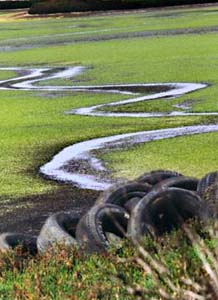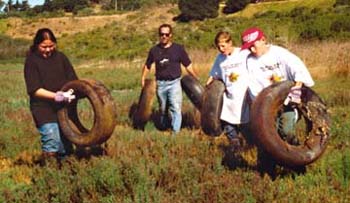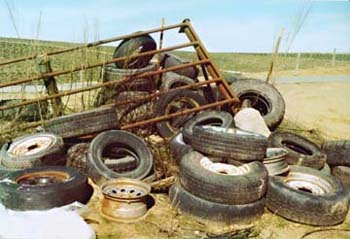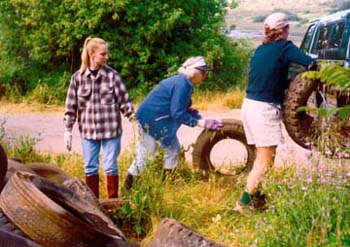![[MetroActive News&Issues]](/gifs/news468.gif)
[ Santa Cruz Week | MetroActive Central | Archives ]
Rubber Soul
Dumped On: The pristine Elkhorn Slough, one of the last healthy sloughs in North America, is a popular spot for discarding old tires.
Scofflaws are dumping used tires by the thousands in the Elkhorn Slough and elsewhere. The problem is: what do we do with them?
By Helene Constant
TEENAGE STUDENT volunteers and their teacher, decked out in yellow waders, slog through the black waters of the slough. In the last two years schoolkids, grandmothers, off-duty soldiers and other volunteers have hauled nearly 2,000 tires out of the slough. Yet they continue to pile up, flung in among the orange pencil legs of downy white egrets.
It was Coastal Clean-up Day and the students were earning extra credit for their science class hauling up heavy, mud-encrusted old tires. They are part of the tidal wave of rubber rubbish, 30 million used tires a year, generated in California--some 260,000 of which come from Santa Cruz County alone, according to Jeffrey Smedberg, county recycling programs coordinator. Of these, some 14 million get recycled in some fashion, but the rest end up in landfills, waterways and stockpiles--both legal and illegal. They are dumped there by people unwilling to pay the minimal fee--between 75 cents and 3 bucks, depending on the size of the tire--to recycle them. Not all dumps accept them, and those that do charge between a dollar and a half and eight dollars.
Winding inland seven miles from Moss Landing, Elkhorn Slough, halfway between Monterey and Santa Cruz, is one of the last healthy sloughs in North America. It's a haven for a variety of plants and animals, including several birds considered rare and endangered, such as the brown pelican, snowy plover and peregrine falcon. At low tide, thousands of shorebirds feed in the mud flats. From Kirby Park visitors have easy access to Elkhorn Slough to kayak, fish or take off on one of the hiking trails.
Or to dump tires.
So far, Monterey County officials have had little luck prosecuting illegal dumpers--people don't tend to leave identification on their tires. Discarded tires become the property of the owner on whose land they are dumped. On public property, like the slough, they end up belonging to you and me.
Jonathan Berkey bumps around the rough roads of the Elkhorn Slough watershed in his off-road vehicle, talking about community-based land management initiatives with farmers, ranchers, scientists and others concerned with the Slough Research Reserve. A former Peace Corps volunteer in Central America, Berkey has been the Elkhorn Slough Watershed coordinator for three years.
"In the fall of 1997, we pulled out the first 600 tires," Berkey says. "There were more but we couldn't get them all. The second year we had two events and pulled out an additional 900 tires." Last May, over 250 tires were taken from the slough and piled at a county yard collection point.
At one of the cleanup sites, Abuela, a tough grandmother, speaks to Berkey in emphatic Spanish. Later in the day, he recalls Abuela.
"One cleanup day I was on the Johnson Road bridge over Carneros Creek," he says. "I saw tires flying up in the air and landing on the embankment. It was Abuela. She's incredibly strong."
Vintage Garbage
AS THEY RUN OUT of room, some California landfills are refusing to accept tires. Moreover, tires don't stay covered up--they "float," working their way to the surface. Manufactured to be durable, they go the distance. On the ground, underground or under water, they refuse to decay.
Tired Out: During Coastal Clean-up Days, school kids, their teachers and other volunteers wade into the waters of Elkhorn Slough to haul out hundreds of old tires.
Jim Griffith is the site superintendent at the Monterey Regional Waste Management District in Marina, one of only a handful of special solid-waste districts in California. The Marina landfill, which still accepts tires, handles not only Monterey County's waste, but the refuse from the city of Capitola as well as yard waste and other debris from Santa Cruz County hauled in by private contractors.
The facility is operated on a "perpetual calendar" of garbage that will, after 90 years, recycle the landfill itself. Griffith offers me a tour, and soon we are bumping over a road that runs on top of 2 feet of soil. Below that is garbage buried between 1966 and 1974. With the delicacy of a winemaker, Griffith recalls the vintages, pointing to areas where this or that year lies buried.
He points out the window of his pickup to an eight-and-a-half acre canyon, empty but for blowing dust and wheeling seagulls. Like the fairy tale in which straw is spun into gold, Griffith's story tells of a future where garbage and tires transformed into wealth and energy. Over the next year, Griffith's crew will sculpt the canyon into a container with 75-foot-high walls. Tire pieces will be laid over a bed of clay and rock, cushioning a network of tubing. The canyon will hold the next 10 years of nonrecyclable waste and will then be capped with another layer of tire pieces.
"Decomposing garbage releases gas, a renewable energy source; we found a way to capture it," says an excited Griffith. "Fifty percent or more of the gas released is methane," he explains. "Methane causes the most damage to the ozone layer of any gas, including carbon dioxide and monoxide. The tire layer helps seal the landfill so that the released gas can easily be captured."
The gas percolates into a 12-inch pipeline to the landfill gas building, where an engine converts it to electricity which is sold to PGE. A heat exchanger heats water for the facility.
"We already gross $20,000 a month turning waste into energy," Griffith says. "Yes, the engine that burns the gas releases some emissions, but they are 20 times less harmful to the biosphere than if they were uncaptured."
Fired Up
WHEN THEY ARE turned away from landfills, many Central Coast tires end up in tire piles. The Westley tire pile near Modesto is the largest in the western United States and one of the four or five largest in the country. Numbering 6 million, it was begun in the 1950s, because the owner believed that someday they would be worth something. At one time it contained 34 million tires, before the California Integrated Waste Management Board started reducing it through burning.
The Modesto Energy Limited Partnership next to the Westley tire pile is the only plant in California that burns tires to make energy. According to the CIWMB, at 2,000 degrees Fahrenheit one tire contains more energy than the same weight of coal--enough to heat a house for a day. Tires are also cheaper to burn than oil or coal, but not cheaper than natural gas, which is driving down the cost of producing electricity.
But the CIWMB, part of the California Environmental Protection Agency, has long cast a wary eye on the Westley tire pile, lest it catch fire. Tire fires are difficult to put out and can burn for months. They send off billows of stinking black smoke full of polynuclear aromatic hydrocarbons, benzene and other toxic pollutants. They ooze oil, and if water is used to fight the fire, the oil travels with it. The fluid then contaminates groundwater, surface water and soil.
A fire at the Royster tire pile near Tracy has been burning for over a year and has consumed 7 million tires. In May 1996, a million and a half tires burned at the Choperena tire pile, in western Fresno County.
An uncontrolled fire at Westley could spread oils across the adjacent Interstate 5 and into the nearby California Aqueduct. As an added adventure, PG&E's major north-south electrical transmission lines run directly over the tire pile.
Despite the ugly pollution from tire fires, CIWMB officials insist that burning tires to produce electricity is relatively safe.
"Tires combusted in a furnace are carefully metered as to quantity and speed, consistent high temperature, sufficiency of air feed, and retention of combustion gases for complete combustion of the hydrocarbons," says Martha Gildart, manager of the board's Waste Tire Management Unit. "The exhaust then goes through a dry-scrubber for removal of sulfur compounds and then a bag-house for removal of particulate matter."
Joyce Eden disagrees. Eden, of Cupertino, is vice chair of the Loma Prieta Sierra Club's Air Quality Committee and also active with West Valley Citizens Air Watch.
"Although tires are a cheap form of fuel, they are expensive to our health," Eden says. "While it is not as obvious a form of pollution as finding tires in wetlands, it is by far more dangerous to the health of any air-breathing organism. Burning tires is not recycling." And, she adds, "the synthetic material takes about seven times more energy to produce than is reclaimed through burning."
Don't Retread on Me
TO AVOID burning, the CIWMB has been trying to find markets for California's 30 million waste tires. In addition to becoming sandals, they can be:
Pilot plants have been erected to decompose tires through pyrolysis (thermal distillation) in an attempt to recycle some of the 15 million barrels of oil that are thrown away in tires in the U.S. each year. But the process has not shown a profit.
At Churchill Downs, the paving blocks of the paddock are made of scrap tires. Air Force One, the Blue Angels and most commercial airliners roll on retreaded tires. Most buses, including school buses, and most taxis are on retreads. So are 10,000 Frito-Lay and 36,000 UPS trucks. But while retreads aren't inferior to new tires, consumers prefer new tires because they are affordable.
"New tires can use at least 10 percent used tire materials, but the companies are afraid to do so, fearing the public will not accept the product," says the Sierra Club's Joyce. "Tests have been done and these tires are no different in performance than those with all-new material."
With each purchase of a new tire in California, 25 cents goes into a fund for cleaning up illegally dumped tires--a program known as remediation. According to a CIWMB report issued to the state Legislature last June, the fee is only a drop in the bucket.
"The $5 million collected annually makes California one of the lowest funded remediation programs in the nation," the report reads. By comparison, Florida has a $12 million program and Illinois collects $8 million annually.
RAC 'Em Up
SOME BELIEVE THAT crumbed and granulated tires are the future. They can be made into mud flaps, hockey pucks, running tracks, carpet padding and office floor anti-fatigue mats. The Japanese have laid railroad track on crumbed tires. Dirt racetracks seeded with crumbed tires are easier on horses. Crumbed tires added to soil will increase porosity and allow more oxygen to reach down to grass roots. Twelve thousand crumbed tires will treat one football field.
Larry Barnblatt is president of Bay Area Tire Recycling. Originally in the business of making the machines that turn tires into crumb rubber, Barnblatt now contracts with San Leandro to crumb its waste tires and sell the crumbs. He has half a dozen machines which grind and shred tires into flour-size granules, then screens them for fiber and metal.
Barnblatt is excited about crumbed tires, especially highways of Rubberized Asphalt Concrete (RAC).
"RAC makes a road that reduces glare and makes a quiet road, a resilient road, a deformation-resistant road," Barnblatt says. "A mile of RAC 36 feet wide and 3 inches thick uses 16,000 tires and lasts twice as long as ordinary asphalt."
Six years ago CalTrans received a grant from CIWMB to pave a section of road on Highway 16, east of Woodland, with RAC on one side and traditional surfacing on the other. In six years CalTrans hasn't had to do any maintenance to the RAC section, but has had to fill cracks on the traditional side.
The Sierra Club's Eden agrees. "There are roads paved with RAC in Arizona whose RAC pavement is over a decade old and still going strong."
"Some RAC pavements have surpassed their design life; some have failed to meet the goal," says the CIWMB's Martha Gildart. "It depends on how knowledgeable the paving contractor is about using these new techniques."
Rubberized asphalt concrete is also quieter than traditional asphalt. "RAC highways lower noise 3 to 5 decibels; our highways will be 50-80 percent quieter," says Lynn Nicholson, an engineer for the County of Los Angeles Rubberized Asphalt Concrete Technology Center, which is funded by CIWMB.
But the substance costs 25 to 100 percent more per ton than conventional asphalt, although itcan be laid thinner to cut costs. Another problem is that laying rubberized asphalt concrete is still an experimental process, and not all attempts are successful.
Rubber Cement
IN LAST JUNE'S report to the Legislature, CIWMB also encouraged more incorporation of used tires into cement production. "The cement-manufacturing industry could use all of the waste tires generated in the state as well as the existing stockpiles," it reads. "From an energy perspective, use of tires as a supplemental fuel in cement kilns displaces fossil fuels and results in no wastes and no significant difference in emissions" between the use of tires and coal in the process.
In Germany and Japan, about 20 percent of the fuel for cement plants is whole tires. There are currently three cement kilns in California that consume whole tires. At the Calaveras Cement Company in Redding, powdered limestone, shale and tires are burned together.
The RMC Lonestar cement plant near Davenport applied for a permit to use tires as fuel but gave up because of opposition to the process. In recent weeks the Sierra Club asked a federal appeals court to force the U.S. Environmental Protection Agency to take action against American cement kilns, no matter what fuel they use.
"Cement kilns are among America's worst polluters," wrote Jane Williams, vice chair of Sierra Club's National Waste Committee, in support of the lawsuit.
Even if there is no agreement on what should be done with the discarded tires, nobody wants to see them remain in Elkhorn Slough. Fortunately, that is a problem everyone can do something about. This year Coastal Clean-up Day, which is sponsored by the California Coastal Commission, is Saturday, Sept. 18, from 9am to noon. For more information call Ecology Action at 426-5925.
Copyright © Metro Publishing Inc. Maintained by Boulevards New Media.
![]()
 Helene Constant
Helene Constant

Helene Constant



From the September 1-8, 1999 issue of Metro Santa Cruz.